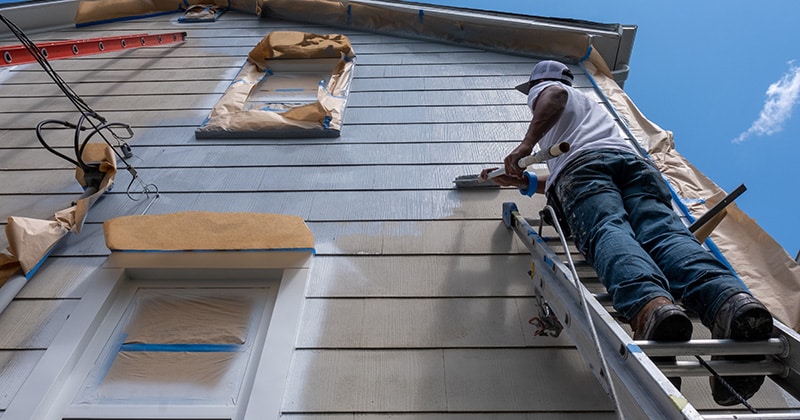The Top 8 Painting Ladders for Pro Painters
Choosing the right painting ladder for each job is an important decision. Get suggestions for different painting ladder models. Plus learn worker safety tips to reduce falls and accidents.

Staff Contributor
Are you starting a painting business? Expanding your existing company? Choosing the right painting ladder for each job is an important decision.
In this article, we’ll give you our top recommendations for different painting ladder models. Plus learn worker safety tips to reduce falls and accidents. You’ll also get information about various ladder types so you can select the right one for every project.
Let’s get started!
The Importance of Choosing the Right Painting Ladder
No matter what you’re doing, you always want the right tools for the job. Having the proper equipment (or not) can impact every area of your business. For example, running a successful painting business requires several key things:
- Completing projects properly and on time
- Maintaining customer satisfaction
- Creating reasonable profit margins
- Ensuring worker safety on the job
You can tick all of these boxes by selecting the right equipment.
When you choose the best tools from the start, you improve both efficiency and quality. That makes customers happy. This in turn generates positive reviews and testimonials to bring in future clients.
That, in turn, ensures revenue streams for financial stability. And the faster you can complete jobs, the more projects you can take on and the greater your ability to make money.
Once you get a reputation for the best possible outcomes, you can charge more for projects too. Property owners will start to come to you, knowing your painting services will give them beautiful results. You can spend less time and money on marketing, which increases profits even more.
Keeping workers safe also has multiple benefits for painting business owners:
- Improved employee retention
- Easier to hire new workers
- Fewer workers’ compensation claims
- Less time lost to accidents and injuries
Think of investing in tools and equipment like buying boots.
You can spend a little more on good-quality footwear that will last for years and keep your feet protected.
Or you can buy cheap boots that wear out every year and need to be replaced. Your feet are always cold and sore. You also spend more money replacing them than you would if you invested in a good pair in the first place.
Which sounds like the smarter option?
When it comes to equipment for your painting business, perhaps nothing is more important than the ladders you buy. They give you the ability to complete jobs properly and efficiently. And the right ladders keep your workers safe, even when working high above the ground.

The Top 8 Painting Ladders for Pro Painters
There are a lot of different criteria that could make a ladder a potential top choice for your business. Ideally, you want to find painting ladders that check as many boxes as possible.
Professional Painting Ladders: Considerations Before Purchase
Think about these issues when exploring ladders for your company:
- Cost—You want ladders you can afford but not ones so cheap that you compromise on quality and safety.
- Ease of use—Setting up, moving around, and taking down equipment at job sites should be quick and uncomplicated.
- Safety—Any ladder you choose must meet minimum safety requirements, including weight capacity.
- Transportation—Painting ladders must fold or collapse to fit inside a van or on a truck rack.
- Lifespan—Commercial ladders take a lot of wear and tear but must last for years to justify their investment.
- Versatility—You should be able to use a painting ladder on most regular one and two-story jobs.
- Extras—Some ladders have special features for convenience or safety that might appeal to your particular needs.
- Brand reputation—What do other professional painters have to say about the company’s ladders?
- Warranties—Does the manufacturer stand behind their products with warranties and service?
Types of Painting Ladders
There are also different ladder styles available. The type of ladder determines where it can be used and how much height you can reach with it.
If you only paint apartment interiors, for instance, you probably don’t need larger models. But most commercial painting businesses prefer to own a variety of ladder styles. This lets them better accommodate different customer needs.
When shopping for painting ladders, understand the differences between these types:
- Step ladder—the smallest type available, typically for working 2-4 feet off the ground
- Platform ladder—similar to a step ladder but with platforms instead of rungs to stand on and usually greater height capability
- Twin step ladder—a higher step ladder that can handle heavier loads, including workers on either side of the ladder
- Articulated (combination) ladder—one with joints that allow for many different configurations
- Extension ladder—telescoping ladders that adjust in height up to about 40 feet for high ceilings and exteriors
- Scaffolding—a system of metal supports and planks that can exceed the height of extension ladders and hold multiple workers
Given the information above, here are 8 painting ladders for professionals. Each comes highly recommended. We’ll go through both the pros and cons of each model, so you can choose which ones are best for your commercial needs.
Little Giant Paint Pro
Priced under $150, this ladder—a favorite with DIYers—can handle commercial work and is great for interior jobs. With a 1AA rating (see explanation below), it can hold up to 375 pounds.
It has only a 4-inch storage width, so it’s ideal for sliding into a van or the back of a pickup. With its weight of just under 16 pounds, anyone can lift and move it easily. Users love the handy utility tray at the top that holds painting supplies and a paper towel roll.
The Little Giant Paint Pro is made of aluminum and comes with a one-year warranty. However, it only has two rungs and one platform step, limiting its use at higher levels.
SocTone 5 Step Ladder with Handrails
The SocTone 5 Step Ladder goes a step beyond the Little Giant, with five platform steps and a similar utility tray at the top.
What makes this ladder stand out are the handrails on either side that make climbing easier and safer. Check out these specs, which make it a solid choice for commercial interiors:
- Weight capacity of 330 pounds
- Gives users an additional 46 inches of height
- Lightweight at 23 pounds
- Under 10 inches wide when folded flat
- Steel frame with reinforced metal supports
- Anti-slip and stability features
One downside to this ladder is that some assembly is required before first-time use. Some users, however, feel it could be a little wider at the base and that stability was reduced for the low price of just over $100.
Lanbitou A-Frame 4-Step Ladder
If you’re looking to experiment with articulated ladders, this model is a good entry point. It can be quickly converted into different types of ladders. This includes an A-frame step ladder and a 14-foot straight extension ladder.
Even better, this ladder lets you adjust the length of each side when in the A-frame mode. That makes it perfect for using on stairs when either side of the base must sit at a different height.
This ladder is designed to hold 300 pounds and weighs 29 pounds itself. Storage size is 47 inches high by 8.5 inches deep.
Some users report the model can be a bit confusing to set up and use at first. Others say customer service is slow to respond to issues. But most buyers give it five stars overall.
Ohuhu Aluminum Telescoping Ladder
For a smaller extension ladder, the Ohuhu Aluminum Telescoping Ladder gets the job done. You can get 12.5 feet out of this ladder, making it more versatile than a step ladder for outside jobs in particular.
A push of a button lets you adjust the ladder’s length and add more rungs. And yet it stores in less than 1 yard in length and 18.9 inches across. It’s an excellent choice if your business vehicle is on the smaller side.
This aluminum alloy retractable ladder weighs 28 pounds and will hold 250 pounds. Users like that the extension mechanism prevents pinched fingers.
That said, some buyers didn’t like having to push so many buttons to reach the ladder’s full extension length. Additionally, some users had problems with the extension parts failing around the one-year mark. However, they were satisfied with the solution provided by the company’s customer service department.
Werner 1524-2 Aluminum D-Rung Extension Ladder
This ladder is ideal if you need more height, extending to 24 feet. It has a duty rating of 300 pounds.
For greater versatility, the base and fly segments of the ladder can be separated. This gives users two shorter ladders as an alternative to one long one.
Buyers appreciate these features of the model:
- Easy extension and retraction with guide brackets
- Sturdy rung joints
- Slip-resistant rungs
- Flat or adjustable shoes that can be locked into place
- Mar-resistant end caps
This is a heavier ladder at 45 pounds, which might make it hard for one person to use. Storage and transport require at least 12 feet, which is the minimum length of the ladder.
Bryner 7-in-1 Multi-Purpose Ladder
If versatility is your prime concern, this ladder might be your best bet. The Bryner 7-in-1 Multi-Purpose Ladder offers multiple configurations at a reasonable price, so you can use it for all kinds of painting jobs.
This ladder can work as a step ladder, extension ladder, or M-shaped articulated ladder. Even more, you can add the included steel scaffold plates to create a broad work platform.
Multiple safety and stability features contribute to this model’s positive reviews. It boasts a weight load of 330 pounds.
This is another model that stores in a small space of 37 inches by 26.9 inches by 10.6 inches for easy transport between painting jobs.
Users say this ladder took much longer than others to use at first because of all the different variations. Some found the base angle tight when using the ladder fully extended. Others said some of the positions were uncomfortable to work in for hours at a stretch.

Casulo 30-Inch Extra Large Aluminum Work Platform
When you want just a little bit of extra height, why invest in a full-size ladder? This foldable work platform is perfect for budget-conscious startup painting businesses.
Like a small aluminum table you can stand on, this platform collapses nearly flat when not in use. The standing area is 29 by 11.8 inches, and you get 20 inches of extra height from it.
With a maximum load of 330 pounds but a weight under 8 pounds and a convenient carry handle, this is a win-win for small jobs.
Users report that the platform is sturdy. However, some felt it could be larger. Also, buyers said they would like to see better anti-slip features on the standing surface.
SupremeEquip 18-Foot Rolling Scaffold Tower
When you really need to tackle high painting jobs, this SupremeEquip Scaffold Tower is the answer. It will hold 1,000 pounds and give users tons of versatility.
You can use this as two 6-foot scaffolds, a 12-foot plus a 6-foot scaffold, or one 18-foot scaffold. Half-inch plywood decks are securely riveted to the supports.
Casters offer 360-degree swivel and can be locked in place. It’s 29 inches wide, which fits through a standard doorway. You can use this inside as well for painting cathedral ceilings.
The length on either side of the scaffold can be adjusted for use on stairs. Safety rails are included to protect workers.
The big downside to this equipment is the price. You’ll pay between $1,000 and $1,500 for this scaffold, which is a serious investment. Setup and storage are also more involved than using extension ladders.
The Importance of Painting Ladder Safety in Projects
Once you find the best painting ladders for your business, you want to protect your investment. And you want to make sure workers are using them properly to ensure their greatest safety.
Follow the tips below to minimize the risk of accidents in painting jobs. Also, use these suggestions for ladder maintenance to increase both their safety and longevity.
Safety Precautions for Preventing Accidents on Professional Painting Jobs
In 2022, there were over 5,000 fatal work injuries in the United States. Problems with ladders were among the top three safety citations issued by OSHA. (OSHA is the government’s Occupational Health and Safety Administration).
First, it’s smart to put together formal safety protocols for all workers using ladders. Create rules and a handbook for how jobs are set up to ensure employee safety at all times.
Consider holding periodic trainings for topics like:
- Proper climbing safety (3-point contact)
- Ladder etiquette with multiple workers
- Securing the bottom of an extension ladder
- Hauling and handling supplies at height
- Setting the proper ladder angle
- Determining the correct ladder height
- Minimizing slippery conditions that lead to falls
- Working around power lines and other hazards
Second, make sure workers understand how all ladders and scaffolding operate. Encourage them to report any safety issues with equipment right away. Never push workers to do something they feel is unsafe.
Third, know how ladder duty ratings work. This information, found on a label that should not be removed, gives the maximum safe load capacity of every ladder. Remember, these ratings include the worker(s) and equipment combined:
- Type IAA (Extra Heavy Duty, Rugged Use)—375 pounds
- Type IA (Extra Heavy Duty, Industrial Use)—300 pounds
- Type I (Heavy Duty, Industrial Use)—250 pounds
- Type II (Medium Duty, Commercial Use)—225 pounds
- Type III (Light Duty, Household Use)—200 pounds
Fourth, understand and communicate these things workers should never do when using a ladder:
- Exceed the weight rating for the given ladder
- Place the ladder on an uneven or too-soft base or on boxes, barrels, etc.
- Tie two or more ladders together to create a longer one
- Move a ladder when someone is already on it
- Lean out to the side beyond the side rails of the ladder
- Use a ladder horizontally (that’s what scaffolding is for)
- Use a ladder in a configuration for which it was not designed
- Have a gap or insufficient space between the ladder and a roofline
- Stand on the last three rungs of an extension ladder
How to Clean, Store, and Maintain Commercial Painting Ladders
There’s a reason fire departments have strict checklists for the maintenance of their equipment. This includes ladders. Likewise, you can use the tips below for ladder cleaning, storage, and inspection. They will prolong the lifespan of your ladders and support worker safety.
- Get in the habit of cleaning ladders after every workday, especially if they’ve been exposed to anything slippery, like oily paints or grease.
- Checking working parts (rivets, connectors, side rails, safety shoes, etc.) prior to setting up for every job.
- Make sure hooks or racks used in storage and transport are adequate, with at least two supporting points to prevent warping. Ladders kept on the exterior of vehicles should be wiped down before use and storage.
- Broken ladders should be marked with a “do not use” sign. Ladders removed from service should be destroyed so they’re not accidentally used by someone else.
Top Takeaway Tips for Selecting a Painting Ladder
-
Be realistic about what a ladder can and cannot do. There are some taller properties or homes on a steep grade where ladders won’t work. To reach their upper levels, you will need to rent scaffolding or a “cherry picker” (boom truck or bucket truck). Don’t compromise safety to push past the height your ladder can reach.
-
Crunch the numbers to decide if buying an expensive ladder is really worth it. If you only use the largest style of extension ladder twice a year, for instance, would it make more sense to rent one?
-
Ask about return policies if you purchase a ladder and find it won’t meet your needs or has a problem. How do refunds and exchanges work? Can you get a replacement or repair quickly so you don’t lose work time and income?
-
Consider talking to your workers about what they would find most helpful in a painting ladder. They may have concerns or wants you hadn’t thought of.
-
Do you do a lot of exterior work and focus on extension ladders? Don’t forget to buy some smaller ladders for interior jobs and exterior tasks close to the ground. Ladders like the Little Giant (reviewed above) cost less and are ideal for inside painting. They can also be used for outside first-floor window trim and door jobs, for example.
-
Plan to have at least one ladder for every worker you have out on jobs on any given day in most situations. Otherwise, you’ll be paying people who can’t paint because they’re waiting for equipment. Every job should be planned for maximum efficiency and profitability.
Alison began her career as a storyteller crafting a variety of engaging content. She has experience in creative writing, marketing, social media, and education. When she's not writing, she's spending time with her family and dog.

Business Solutions For Field Service Pros
EverPro offers specialized solutions designed for home and field service professionals. We’ve got the business tools to help you get the job done.



